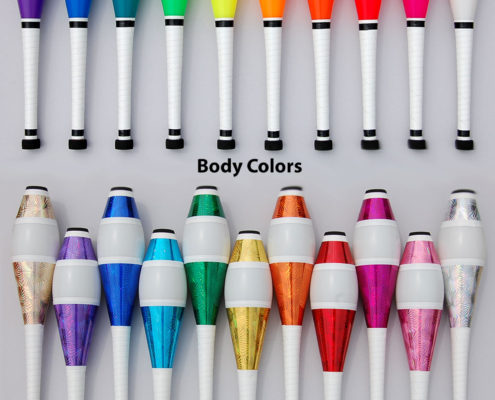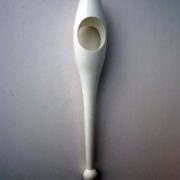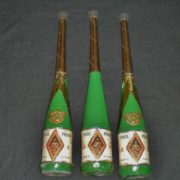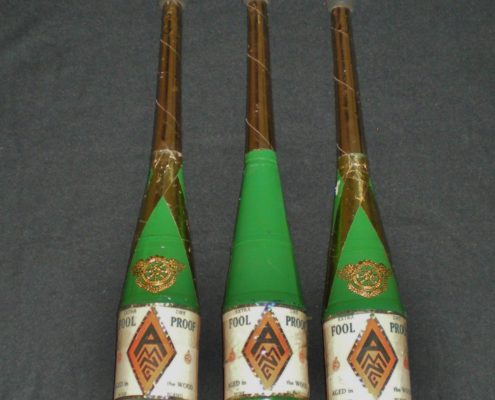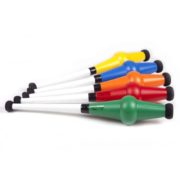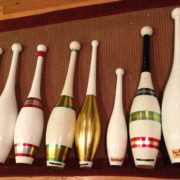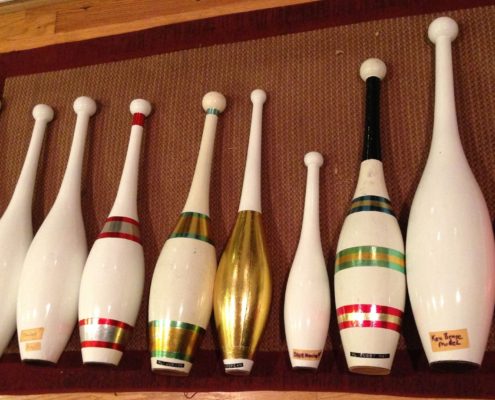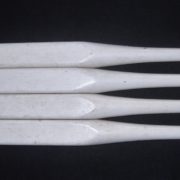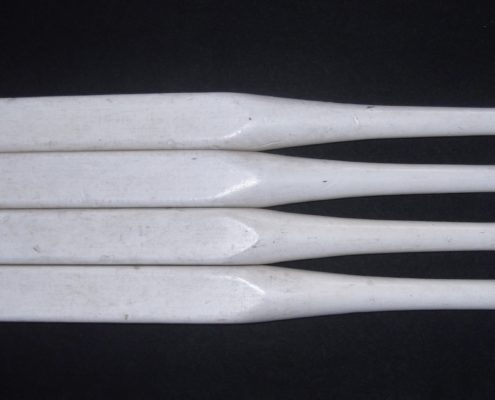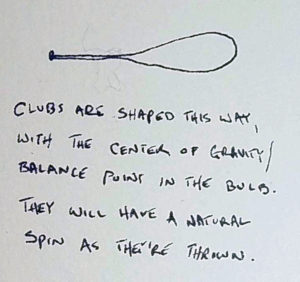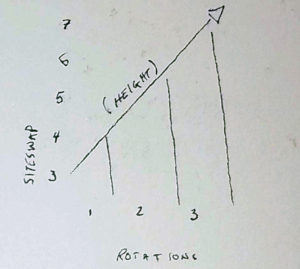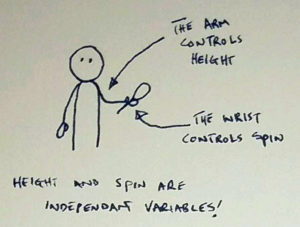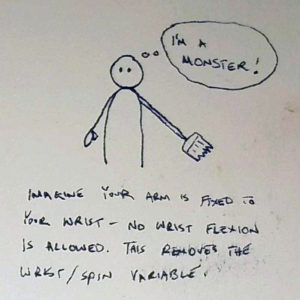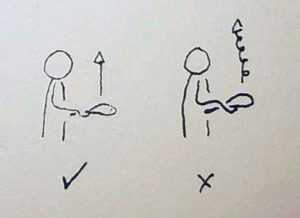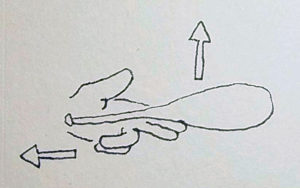Spin Control
One of the nice things about juggling clubs is that they spin in the air.
One of the bad things about juggling clubs is that you have to learn how to control them properly.
In this article, we’ll talk about:
- The natural spin of a juggling club.
- How (and why!) height and spin are independent variables.
- How to properly throw a flat.
- Drills that will help you master different spins at different heights.
Prerequisites
These drills are good for any club juggler – from basic proficiency with a three club cascade to mastery of tricks with five.
Why are clubs weighted like that?
There are hundreds of different types of juggling clubs out there, made by companies across the world (and all across time!)
These clubs all have something in common – the balance point of the club – their center of gravity – is located past the handle, in the bulb.
(If you’re interested in learning about the development of the juggling club, check out David Cain’s excellent series on eJuggle, the online magazine of the International Jugglers’ Association.)
Clubs are shaped this way, so that they have a natural rotation that occurs at different heights – the result of being thrown up into the air. Generally speaking, the closer the center of gravity is to the mid-point of the club, the faster it will spin.
Height and spin
We’re going to use the natural spin of the club as a baseline to get started. As with all rules, though, know that we’re going to break this later on as we get going.
Though siteswap is a measure of time, we’re going to use the siteswap as a placeholder for height. (Don’t understand what I’m talking about? Check out this primer on siteswap notation here.)
In this diagram, you can see that as height increases, so does the number of rotations.
A siteswap 3 (the three club cascade) is at a height where the club will spin with one rotation on its own.
Siteswaps 4 & 5 (the four club fountain or five club cascade) are thrown to a height where the club will rotate twice on its own.
6 & 7 (six fountain and seven cascade) reach a height where they spin three times before being caught.
So, are height and spin the same thing?
Say it with me: Height and spin are independent variables. Height and spin are independent variables.
Height and spin are independent variables.
This is the one truth of club juggling. This is your mantra as you progress.
The arm has a bunch of joints in it. When talking about spin control, we lump them into two categories: the wrist joints and the other joints. When you juggle clubs, you’re using the wrist and the arm together, resulting in a throw that rotates in a desired spin. If you’re juggling three clubs in singles, you’re already using this system to achieve success. Next, we have to start changing our technique to get a better understanding of how it all works.
Remember: The wrist controls the spin. The rest of the arm controls the height.
Understanding this, let’s do some drills.
Club control drills
Here are a variety of drills for you to work on. These are not put in any particular order – feel free to incorporate these at random into your training. These drills are all designed to help you focus on different aspects of spin control. Working on a few of these drills in the same session will help you progress more quickly than just focusing a single drill.
Warming up
Before you start on these drills, let’s refresh our baseline – that natural height/rotation that you’re already familiar with.
Start off with 20x 3-height single throws. Then move on to 20x 5-height doubles. Then on to 20x 7-height triples.
Once those are warmed up, run single-double-triple for 20 iterations. (So, a series of throws that’s 3-5-7. That’s not a valid siteswap – technically we’re talking about 352272222.) This exercise is designed to single out each throw so you’re looking at them as individual units, rather than a pattern.
Arms only
Imagine for a moment that you don’t have wrists at all. Your arm has been replaced by some kind of terrible broomstick apparatus that’s connected at the shoulder.
Understanding that height and spin are independent of one another, when we remove the wrist (the spin joint) from the equation, we’re just left with the rest of the arm – the part that controls height.
Working with one club, throw a single-spin 3. That’s the height where the club naturally rotates one time.
Now, try throwing a single-spin 5. A 5 is ordinarily done as a double, as your natural throw makes the club spin twice. Try throwing the club in the air with just your arm, and none of the wrist at a 5-height. You’ll need to follow through more than you ordinarily would.
After this, try throwing a 7-height throw as a single. You’ll need to follow through even more.
Once you get the feel of these different height single-spin throws with one club, using both your left and your right hands, try juggling three clubs as single spin throws, at all three heights. Can you get 20 catches of each height?
Wrists only
Since the arm controls the height and the wrist controls the spin, wrist-only drills are done at height 3. With these drills, we focus on learning how to add more wrist to achieve double and triple spins at a 3 height.
We’ll start with the basics, as we did the arm-only drills. One club, thrown as a natural single-spin 3. Adding an amount of flick with the wrist, try to throw a club as a double at the exact same height. Next, try throwing a triple at the height of 3.
It should feel as though you’re pushing the handle down with your thumb as the wrist follows through.
Next, work on juggling three clubs in singles. Then, without changing the height at all, try throwing all double-spins. Next, work on triples.
If you can get a run of 60 catches in single run – 20x single, 20x double, and 20x triple – you’re in a good place.
I like you. You’re an honest person. You wouldn’t tell me that you’re juggling them all at the same height if you’re not, right? Don’t cheat yourself!
When you train both arm-only and wrist-only drills alongside one another, you begin to understand the relationship between height and spin – the relationship between height and spin – and how they can be manipulated independently of one another.
Breaking old assumptions
If you’ve already learned how to juggle 441 and 531 with clubs, odds are that you’ve learned those 5s and 4s as doubles, and the 3 as a single. Let’s mix that up!
Try working on 441 with double-height triples and double-height singles. After that, try 441 with a double-height single on one side and with a double-height triple on the other.
Work on 531 with a double-height single as the 5 and a single-height double as the 3.
Can you run these patterns?
What about flats? How do you throw a club with no spin at all?
A flat is a throw with no spin – it is released horizontally, flies without any rotation, and lands in the same horizontal position.
When jugglers first learn this trick on their own, they often roll the club sideways off of their fingers. This is a bad habit that will give you problems if you want to learn four and five clubs in flats in the future, or work on variations with three.
To properly execute a flat, place your pointer finger under the balance point of the club. As you lift with your arm, pull your finger backwards along the club’s handle to ensure it stays parallel to the ground.
It’s simple in theory, but takes some practice to get consistent. Rolling is easier, but again – it’ll give you bad habits down the line.
Throwing reverse spins with clubs is a similar technique, but with a much more aggressive movement of the finger on the handle, pushing it up and away from your body.
How about half-spins?
Half spins are where you throw a club by the handle, then catch it by the bulb. This is an important spin to learn as you progress, as it opens up a variety of catches (oh-shits and slapbacks,) and is the starting grip for a number of rolls and fancy contact-club tricks.
To throw a half-spin, you simply reduce the amount of wrist used even further – the line of the arm hardly breaks at the wrist at all during the throw.
Two nice drills for this are tennis with a half (so, one club is tossed back and forth as a half spin.) Work on this starting with both hands, that way each hand gets used to catching the bulb of the club and returning it as a half.
Next, start working on an all-half cascade. Can you get 20 catches of this pattern?
What’s the next step?
The sky’s the limit!
I’d suggest working on four clubs in singles, and working on as many spin variations on all of the classic siteswaps. (5551, 534, 633, etc.) Working on 5551 in singles is a great training tool for running a five club cascade in singles (or, “fingles” as American performer Kevin Axtell likes to call them!)
Working on double-spins at single height with three is also an incredible training tool for five clubs in double spins. That might sound like an oblique approach, but learning the separation of the arm and the wrist gives you an incredible foundation for higher numbers.


